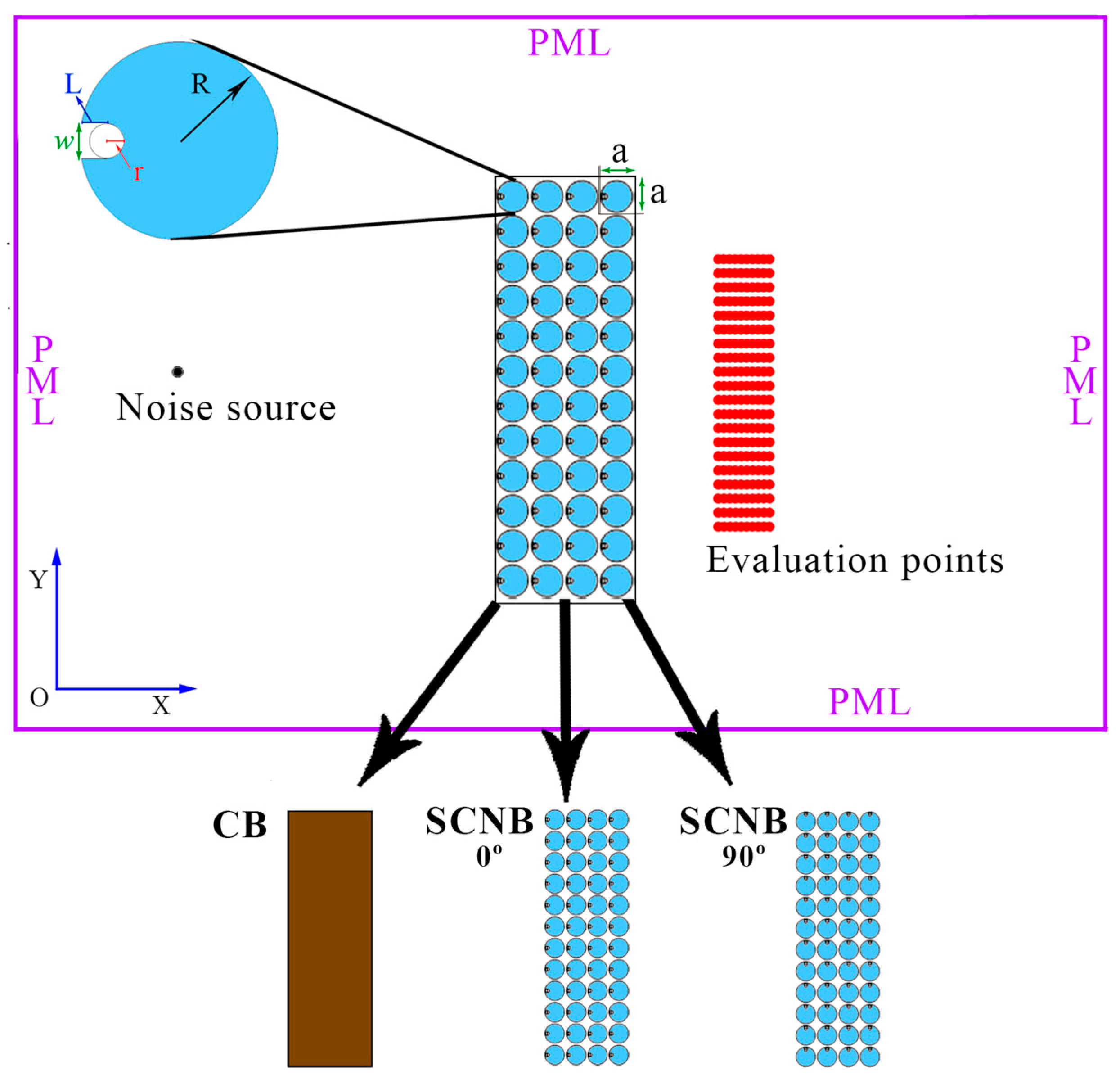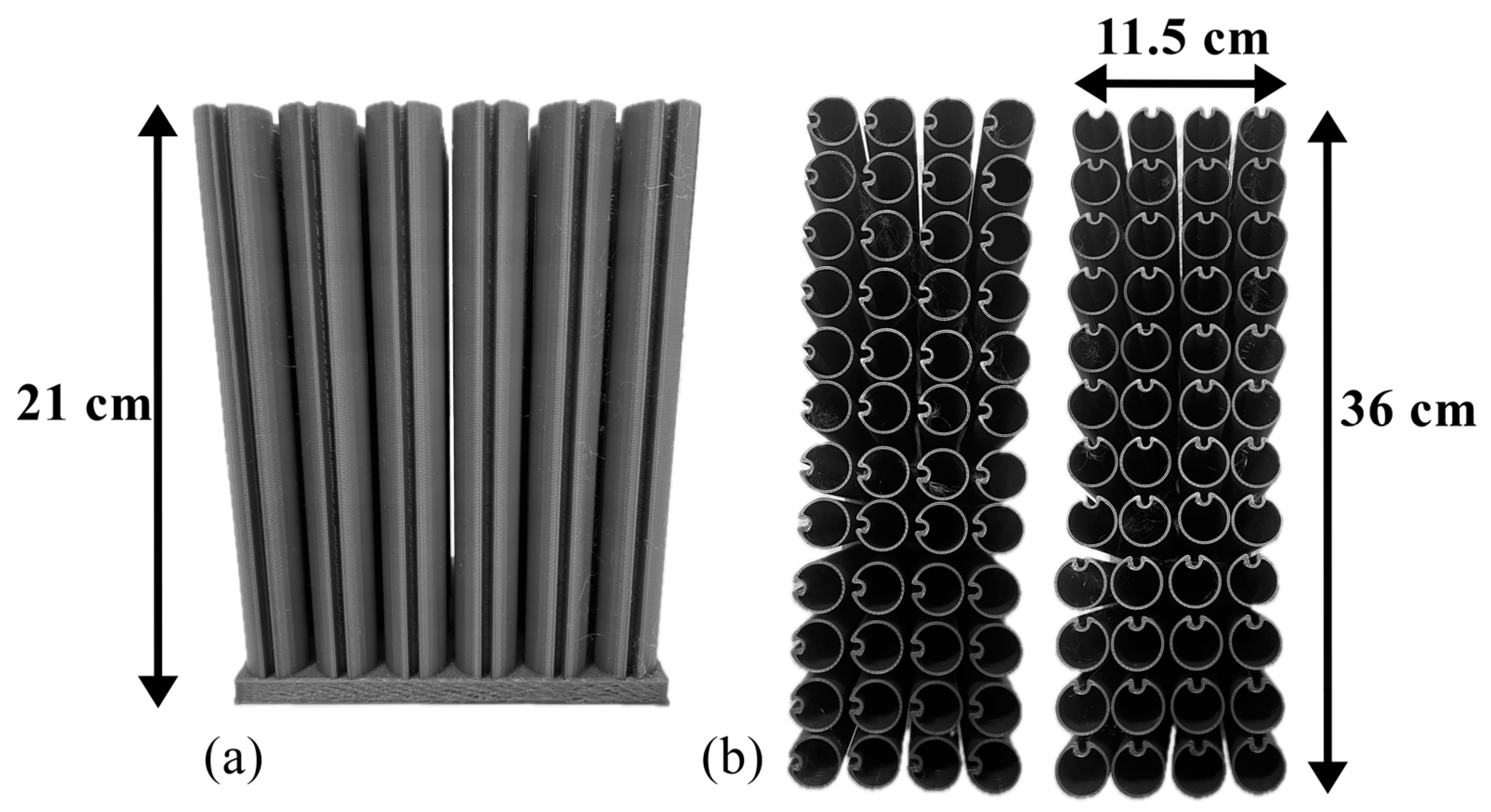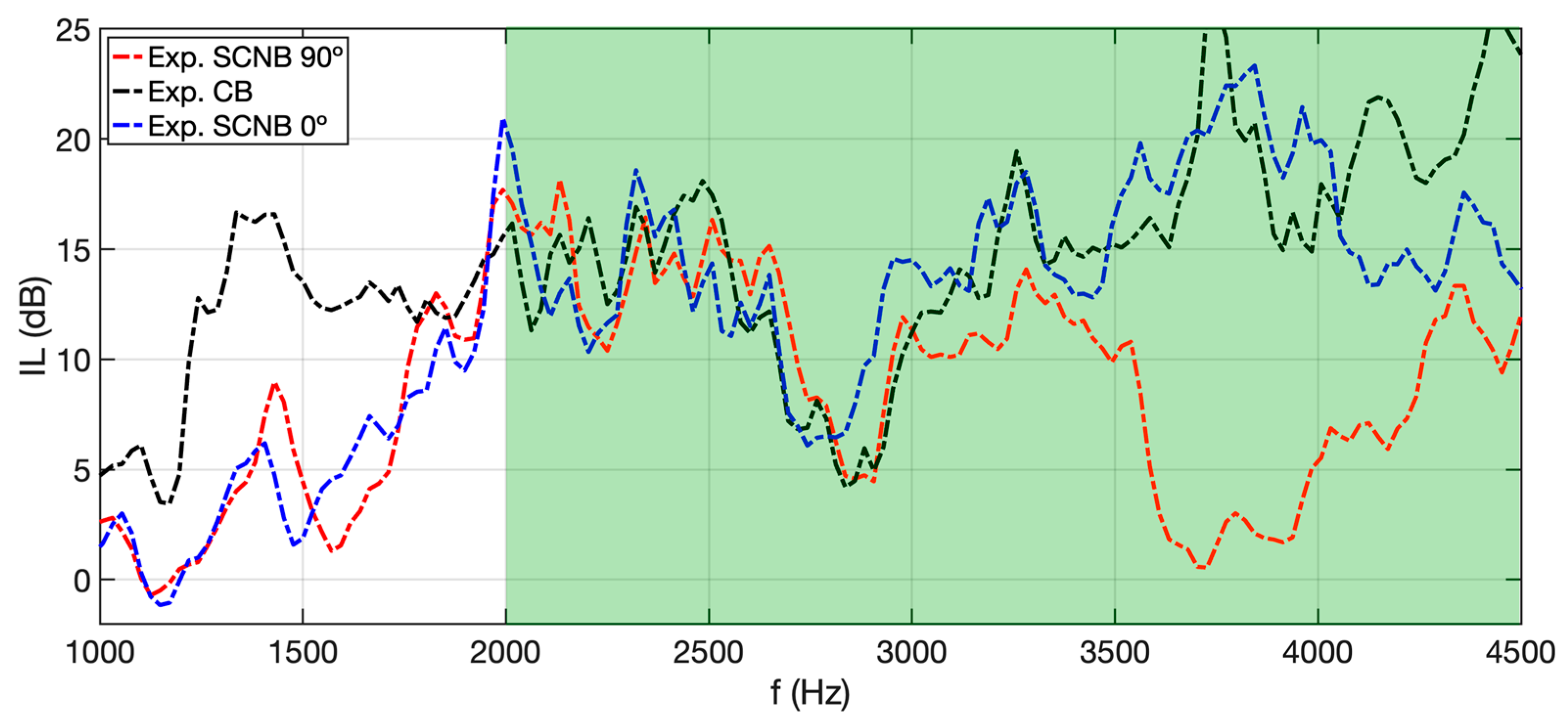Sonic Crystal Noise Barrier with Resonant Cavities for Train Brake Noise Mitigation
Abstract
:1. Introduction
2. Materials and Methods
2.1. Numerical 2D Model
2.2. Experimental Set Up
3. Results
3.1. Numerical Results
3.2. Application of the Insertion Loss Obtained via In Situ Measurements of the TBN
4. Conclusions
Author Contributions
Funding
Data Availability Statement
Acknowledgments
Conflicts of Interest
References
- European Commission; Directorate General for Environment; The European Parliament and the Council of the European Union. Implementation of the Environmental Noise Directive in Accordance with Article 11 of Directive 2002/49/EC; European Comission: Brussels, Belgium, 2023.
- Lin, J.-Y.; Cheng, W.-J.; Wu, C.-F.; Chang, T.-Y. Associations of Road Traffic Noise and Its Frequency Spectrum with Prevalent Depression in Taichung, Taiwan. Front. Public Health 2023, 11, 1116345. [Google Scholar] [CrossRef]
- Polak, K.; Korzeb, J. Modelling the Acoustic Signature and Noise Propagation of High Speed Railway Vehicle. Arch. Transp. 2022, 64, 73–87. [Google Scholar] [CrossRef]
- Chiello, O.; Sinou, J.-J.; Vincent, N.; Vermot Des Roches, G.; Cocheteux, F.; Bellaj, S.; Lorang, X. Squeal Noise Generated by Railway Disc Brakes: Experiments and Stability Computations on Large Industrial Models. J. Acoust. Soc. Am. 2013, 133, 3461. [Google Scholar] [CrossRef]
- Cascetta, F.; Caputo, F.; De Luca, A. Squeal Frequency of a Railway Disc Brake Evaluation by FE Analyses. Adv. Acoust. Vib. 2018, 2018, 4692570. [Google Scholar] [CrossRef]
- Jansen, E.H.; Dittrich, M.G.; Sikma, E.L. Brake Noise Measurements on Mixed Freight Trains with Composite Brake Blocks. J. Acoust. Soc. Am. 2008, 123, 3266. [Google Scholar] [CrossRef]
- Lázaro, J.; Pereira, M.; Costa, P.A.; Godinho, L. Performance of Low-Height Railway Noise Barriers with Porous Materials. Appl. Sci. 2022, 12, 2960. [Google Scholar] [CrossRef]
- Tickell, C.E.; Downing, P.; Jacobsen, C.J. Rail Wheel Squeal—Some Causes and a Case Study of Freight-Car Wheel Squeal Reduction. In Proceedings of the Acoustics 2004, Gold Coast, Australia, 3 November 2004; pp. 239–244. [Google Scholar]
- Harris, C.M. Handbook of Acoustical Measurements and Noise Control; McGraw-Hill: New York, NY, USA, 1991; pp. 3019–3020. [Google Scholar]
- Maekawa, Z. Noise Reduction by Screens. Appl. Acoust. 1968, 1, 157–173. [Google Scholar] [CrossRef]
- Branco, F.J.F.G.; Godinho, L.; Tadeu, A. Acoustic Insertion Loss Provided by Rigid Acoustic Barriers of Different Shapes. J. Comput. Acoust. 2003, 11, 503–519. [Google Scholar] [CrossRef]
- Jolibois, A.; Defrance, J.; Koreneff, H.; Jean, P.; Duhamel, D.; Sparrow, V.W. In Situ Measurement of the Acoustic Performance of a Full Scale Tramway Low Height Noise Barrier Prototype. Appl. Acoust. 2015, 94, 57–68. [Google Scholar] [CrossRef]
- Sousa, L.; Pereira, L.; Montes-González, D.; Ramos, D.; Amado-Mendes, P.; Barrigón-Morillas, J.M.; Godinho, L. Experimental Analysis and Simulation of a Porous Absorbing Layer for Noise Barriers. Appl. Sci. 2023, 13, 2638. [Google Scholar] [CrossRef]
- Fusaro, G.; Garai, M. Acoustic Requalification of an Urban Evolving Site and Design of a Noise Barrier: A Case Study at the Bologna Engineering School. Appl. Sci. 2024, 14, 1837. [Google Scholar] [CrossRef]
- Sanchez-Perez, J.V.; Rubio, C.; Martinez-Sala, R.; Sanchez-Grandia, R.; Gomez, V. Acoustic Barriers Based on Periodic Arrays of Scatterers. Appl. Phys. Lett. 2002, 81, 5240–5242. [Google Scholar] [CrossRef]
- Kushwaha, M.S. Stop-Bands for Periodic Metallic Rods: Sculptures That Can Filter the Noise. Appl. Phys. Lett. 1997, 70, 3218–3220. [Google Scholar] [CrossRef]
- D’Orazio, T.; Asdrubali, F.; Godinho, L.; Veloso, M.; Amado-Mendes, P. Experimental and Numerical Analysis of Wooden Sonic Crystals Applied as Noise Barriers. Environments 2023, 10, 116. [Google Scholar] [CrossRef]
- Morandi, F.; Miniaci, M.; Marzani, A.; Barbaresi, L.; Garai, M. Standardised Acoustic Characterisation of Sonic Crystals Noise Barriers: Sound Insulation and Reflection Properties. Appl. Acoust. 2016, 114, 294–306. [Google Scholar] [CrossRef]
- Martínez-Sala, R.; Sancho, J.; Sánchez-Pérez, J.V.; Gómez, V.; Llinares, J.; Meseguer, F. Sound Attenuation by Sculpture. Nature 1995, 378, 241. [Google Scholar] [CrossRef]
- Yang, W.; Ouyang, D.; Deng, E.; He, X.; Zou, Y.; Huang, Y. Aerodynamic Characteristics of Two Noise Barriers (Fully Enclosed and Semi-Enclosed) Caused by a Passing Train: A Comparative Study. J. Wind Eng. Ind. Aerodyn. 2022, 226, 105028. [Google Scholar] [CrossRef]
- Zheng, J.; Li, Q.; Li, X.; Luo, Y. Train-Induced Fluctuating Pressure and Resultant Dynamic Response of Semienclosed Sound Barriers. Shock Vib. 2020, 2020, 6901564. [Google Scholar] [CrossRef]
- Minelli, G.; Yao, H.-D.; Andersson, N.; Lindblad, D.; Forssén, J.; Höstmad, P.; Krajnović, S. Using Horizontal Sonic Crystals to Reduce the Aeroacosutic Signature of a Simplified ICE3 Train Model. Appl. Acoust. 2021, 172, 107597. [Google Scholar] [CrossRef]
- Wu, X.; He, X.; Huang, J. Comparative Analysis of Dynamic Responses of Different Types of High-Speed Railway Noise Barriers under the Influence of Fluctuating Wind Pressure. Sustainability 2022, 14, 12900. [Google Scholar] [CrossRef]
- Economou, E.N.; Sigalas, M.M. Elastic and Acoustic Wave Band Structure. J. Sound Vib. 1992, 158, 377–382. [Google Scholar]
- Chen, Y.-Y.; Ye, Z. Theoretical Analysis of Acoustic Stop Bands in Two-Dimensional Periodic Scattering Arrays. Phys. Rev. E 2001, 64, 036616. [Google Scholar] [CrossRef] [PubMed]
- Kittel, C. Introduction to Solid State Physics, 8th ed.; Wiley: Hoboken, NJ, USA, 2005; ISBN 978-0-471-41526-8. [Google Scholar]
- Zhang, S.; Liu, J.; Zhang, H.; Wang, S. Tunable Low Frequency Band Gap and Waveguide of Phononic Crystal Plates with Different Filling Ratio. Crystals 2021, 11, 828. [Google Scholar] [CrossRef]
- Miyashita, T. Sonic Crystals and Sonic Wave-Guides. Meas. Sci. Technol. 2005, 16, R47–R63. [Google Scholar] [CrossRef]
- Redondo, J.; Picó, R.; Sánchez-Morcillo, V.J.; Woszczyk, W. Sound Diffusers Based on Sonic Crystals. J. Acoust. Soc. Am. 2013, 134, 4412–4417. [Google Scholar] [CrossRef]
- Lee, H.M.; Hua, Y.; Xie, J.; Lee, H.P. Parametric Optimization of Local Resonant Sonic Crystals Window on Noise Attenuation by Using Taguchi Method and ANOVA Analysis. Crystals 2022, 12, 160. [Google Scholar] [CrossRef]
- Li, X.-L.; Lam, W.K.; Tang, S.K. Experimental Investigation on the Enhancement of Plenum Window Noise Reduction Using Solid Scatterers. J. Acoust. Soc. Am. 2023, 153, 1361–1374. [Google Scholar] [CrossRef]
- Lardeau, A.; Groby, J.-P.; Romero-García, V. Broadband Transmission Loss Using the Overlap of Resonances in 3D Sonic Crystals. Crystals 2016, 6, 51. [Google Scholar] [CrossRef]
- Liu, Z.; Zhang, X.; Mao, Y.; Zhu, Y.Y.; Yang, Z.; Chan, C.T.; Sheng, P. Locally Resonant Sonic Materials. Science 2000, 289, 1734–1736. [Google Scholar] [CrossRef]
- Lagarrigue, C.; Groby, J.P.; Tournat, V.; Dazel, O.; Umnova, O. Absorption of Sound by Porous Layers with Embedded Periodic Arrays of Resonant Inclusions. J. Acoust. Soc. Am. 2013, 134, 4670–4680. [Google Scholar] [CrossRef]
- Cavalieri, T.; Cebrecos, A.; Groby, J.-P.; Chaufour, C.; Romero-García, V. Three-Dimensional Multiresonant Lossy Sonic Crystal for Broadband Acoustic Attenuation: Application to Train Noise Reduction. Appl. Acoust. 2019, 146, 1–8. [Google Scholar] [CrossRef]
- Romero-García, V.; Sánchez-Pérez, J.V.; Garcia-Raffi, L.M. Tunable Wideband Bandstop Acoustic Filter Based on Two-Dimensional Multiphysical Phenomena Periodic Systems. J. Appl. Phys. 2011, 110, 014904. [Google Scholar] [CrossRef]
- Yuan, B.; Humphrey, V.F.; Wen, J.; Wen, X. On the Coupling of Resonance and Bragg Scattering Effects in Three-Dimensional Locally Resonant Sonic Materials. Ultrasonics 2013, 53, 1332–1343. [Google Scholar] [CrossRef]
- Cenedese, M.; Belloni, E.; Braghin, F. Interaction of Bragg Scattering Bandgaps and Local Resonators in Mono-Coupled Periodic Structure. J. Appl. Phys. 2021, 129, 124501. [Google Scholar] [CrossRef]
- Redondo, J.; Ramírez-Solana, D.; Picó, R. Increasing the Insertion Loss of Sonic Crystal Noise Barriers with Helmholtz Resonators. Appl. Sci. 2023, 13, 3662. [Google Scholar] [CrossRef]
- Peiró-Torres, M.P.; Castiñeira-Ibáñez, S.; Redondo, J.; Sánchez-Pérez, J.V. Interferences in Locally Resonant Sonic Metamaterials Formed from Helmholtz Resonators. Appl. Phys. Lett. 2019, 114, 171901. [Google Scholar] [CrossRef]
- Redondo, J.; Godinho, L.; Staliunas, K.; Vicente Sánchez-Pérez, J. An Equivalent Lattice-Modified Model of Interfering Bragg Bandgaps and Locally Resonant Stop Bands for Phononic Crystal Made from Locally Resonant Elements. Appl. Acoust. 2023, 211, 109555. [Google Scholar] [CrossRef]
- Peiró-Torres, M.P.; Parrilla Navarro, M.J.; Ferri, M.; Bravo, J.M.; Sánchez-Pérez, J.V.; Redondo, J. Sonic Crystals Acoustic Screens and Diffusers. Appl. Acoust. 2019, 148, 399–408. [Google Scholar] [CrossRef]
- Ramírez-Solana, D.; Redondo, J.; Mangini, A.M.; Fanti, M.P. Particle Swarm Optimization of Resonant Sonic Crystals Noise Barriers. IEEE Access 2023, 11, 38426–38435. [Google Scholar] [CrossRef]
- Berenger, J.-P. A Perfectly Matched Layer for the Absorption of Electromagnetic Waves. J. Comput. Phys. 1994, 114, 185–200. [Google Scholar] [CrossRef]
- Stinson, M.R. The Propagation of Plane Sound Waves in Narrow and Wide Circular Tubes, and Generalization to Uniform Tubes of Arbitrary Cross-Sectional Shape. J. Acoust. Soc. Am. 1991, 89, 550–558. [Google Scholar] [CrossRef]
- Rhinoceros 3D. (2023, November). Rhinoceros 3D Website. Available online: https://www.rhino3d.com/ (accessed on 19 January 2024).
- Fusaro, G.; Barbaresi, L.; Cingolani, M.; Garai, M.; Ida, E.; Prato, A.; Schiavi, A. Investigation of the Impact of Additive Manufacturing Techniques on the Acoustic Performance of a Coiled-Up Resonator. J. Acoust. Soc. Am. 2023, 153, 2921. [Google Scholar] [CrossRef] [PubMed]
- Redondo, J.; Gaja-Silvestre, P.; Godinho, L.; Amado-Mendes, P. A Simple Method to Estimate the In Situ Performance of Noise Barriers. Appl. Sci. 2022, 12, 7027. [Google Scholar] [CrossRef]






| Case | SPL without Barrier (dBA) | SPL SCNB 0° (dBA) | SPL SCNB 90° (dBA) |
|---|---|---|---|
| Jansen et al. [6] (1) | 71.3 | 63.4 | 63.6 |
| Jansen et al. [6] (2) | 77.9 | 70.7 | 71.0 |
| Jansen et al. [6] (3) | 78.2 | 68.9 | 69.7 |
| Lázaro et al. [7] (1) | 80.1 | 66.2 | 69.4 |
| Lázaro et al. [7] (2) | 79.5 | 75.4 | 75.3 |
| Lázaro et al. [7] (3) | 68.8 | 55.2 | 58.2 |
Disclaimer/Publisher’s Note: The statements, opinions and data contained in all publications are solely those of the individual author(s) and contributor(s) and not of MDPI and/or the editor(s). MDPI and/or the editor(s) disclaim responsibility for any injury to people or property resulting from any ideas, methods, instructions or products referred to in the content. |
© 2024 by the authors. Licensee MDPI, Basel, Switzerland. This article is an open access article distributed under the terms and conditions of the Creative Commons Attribution (CC BY) license (https://creativecommons.org/licenses/by/4.0/).
Share and Cite
Ramírez-Solana, D.; Galiana-Nieves, J.; Picó, R.; Redondo, J.; Sangiorgio, V.; Graziano, A.V.; Parisi, N. Sonic Crystal Noise Barrier with Resonant Cavities for Train Brake Noise Mitigation. Appl. Sci. 2024, 14, 2753. https://doi.org/10.3390/app14072753
Ramírez-Solana D, Galiana-Nieves J, Picó R, Redondo J, Sangiorgio V, Graziano AV, Parisi N. Sonic Crystal Noise Barrier with Resonant Cavities for Train Brake Noise Mitigation. Applied Sciences. 2024; 14(7):2753. https://doi.org/10.3390/app14072753
Chicago/Turabian StyleRamírez-Solana, David, Jaime Galiana-Nieves, Rubén Picó, Javier Redondo, Valentino Sangiorgio, Angelo Vito Graziano, and Nicola Parisi. 2024. "Sonic Crystal Noise Barrier with Resonant Cavities for Train Brake Noise Mitigation" Applied Sciences 14, no. 7: 2753. https://doi.org/10.3390/app14072753






